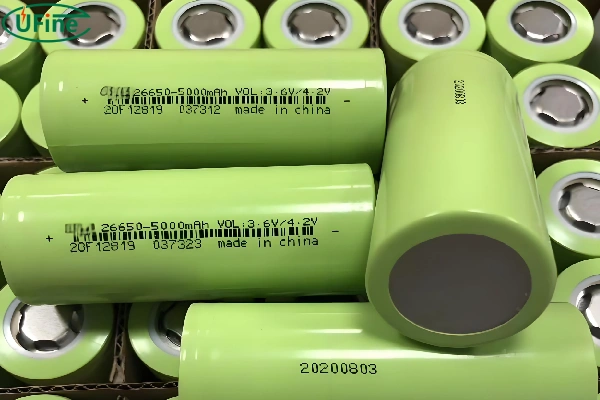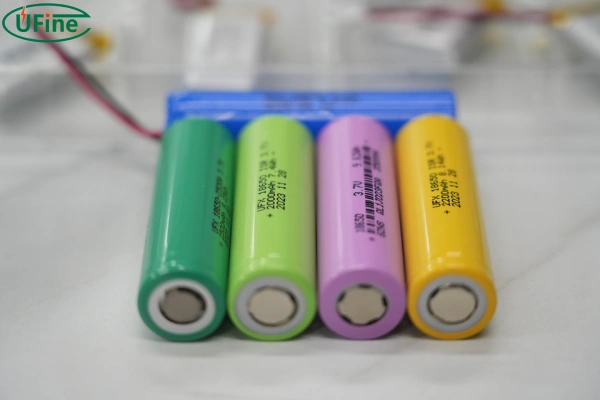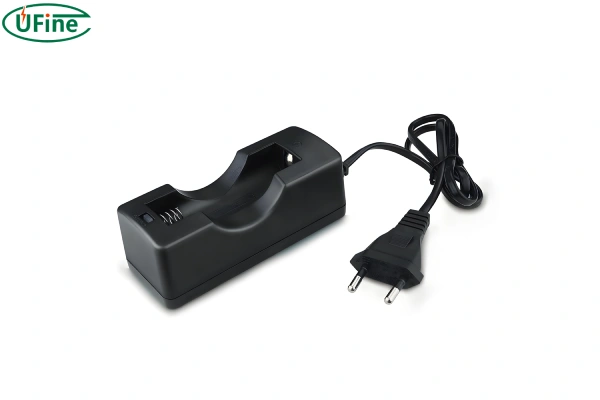If you’re diving into the world of batteries, especially for high-drain devices, you’ve probably come across the term “26650 battery.” These power-packed batteries are becoming increasingly popular, but what exactly are they? How do they differ from other batteries? In this guide, we’ll break down everything you need to know about 26650 batteries, from their size and types to their advantages and applications. Plus, we’ll share some essential maintenance tips to help you get the most out of your battery.
Part 1. What is the 26650 battery?

The 26650 battery is a type of rechargeable lithium battery, named after its dimensions: 26mm in diameter and 65mm in length. This cylindrical cell is known for its high capacity and long-lasting performance, making it a favorite for devices that demand a lot of power. Unlike standard AA or AAA batteries, the 26650 battery can deliver more energy, making it ideal for high-drain devices like flashlights, power tools, and electric bikes. Its robust design and ability to handle high currents without losing efficiency are what set it apart from other battery types.
Part 2. 26650 battery size
The size of a 26650 battery is one of its most distinguishing features. Measuring 26mm in diameter and 65mm in length, these batteries are larger than many other types, such as the 18650 battery. This larger size translates to a greater energy storage capacity. The benefit? Devices using 26650 batteries can operate for longer periods without needing a recharge. This is particularly useful for high-drain applications where consistent and reliable power is crucial. Imagine a flashlight that stays bright for your entire camping trip or a power tool that doesn’t quit halfway through a project. That’s the kind of performance you can expect from a 26650 battery.
Part 3. 26650 battery types
26650 batteries come in various types, each suited for different applications. The most common types include:
- Lithium-Ion (Li-ion): Known for high energy density and long lifespan. Ideal for most high-drain devices.
- IMR (Lithium Manganese Oxide): Offers a balance of safety and performance with high discharge rates.
- INR (Lithium Nickel Manganese Cobalt Oxide): Combines the stability of IMR with the higher capacity of Li-ion batteries.
26650 vs 18650 Rechargeable Batteries: The Ultimate Guide
Each type has its pros and cons. For instance, Li-ion batteries are excellent for devices that need prolonged usage times, while IMR batteries are often used where safety and high discharge rates are prioritized. INR batteries strike a balance, offering good capacity and stable performance. Choosing the right type depends on your specific needs and the device you intend to power.
Part 4. 26650 lithium battery
The 26650 lithium battery stands out for its efficiency and durability. Lithium-ion technology provides a higher voltage per cell compared to other chemistries, making these batteries more efficient. They can deliver a consistent amount of power over a longer period, which is perfect for high-drain devices. Whether you need a reliable power source for your flashlight, electric bike, or portable speaker, a 26650 lithium battery ensures that your device performs at its best. The high energy density means you get more power without significantly increasing the size or weight of your device, which is a significant advantage in many applications.
Part 5. Are all 26650 batteries rechargeable?
Most 26650 batteries available today are rechargeable, which is great for both your wallet and the environment. Rechargeable 26650 batteries allow for multiple uses, reducing the need for constant replacements. This is particularly beneficial for high-drain devices, which can consume a lot of power. However, it’s essential to verify whether a 26650 battery is rechargeable before purchasing. Look for labels like “Li-ion” or “rechargeable” to ensure you’re getting a battery that can be recharged safely. Non-rechargeable 26650 batteries do exist, but they are less common and typically not recommended for high-drain applications.
Part 6. How long does a 26650 battery last?
The lifespan of a 26650 battery depends on various factors, including how often it’s used, charging habits, and maintenance. Generally, a well-maintained 26650 battery can last between 300 to 500 charge cycles. If you charge your battery every day, this translates to about one to two years of use. However, if you follow best practices like avoiding full discharges and storing the battery in a cool, dry place, you can extend its lifespan significantly. It’s also worth noting that the type of 26650 battery can affect its longevity. For instance, lithium-ion batteries tend to have longer lifespans compared to IMR batteries.
Part 7. 26650 battery advantages
There are numerous advantages to using 26650 batteries. Here are some key benefits:
- High Capacity: 26650 batteries can store more energy than many other types, providing longer usage times.
- Durability: Built to withstand many charge cycles, these batteries are designed for long-term use.
- Efficiency: They deliver power efficiently, maximizing the performance of your devices.
- Versatility: Suitable for a wide range of applications, from flashlights to power tools.
- Safety: Many 26650 batteries come with built-in protection circuits to prevent overcharging and overheating.
These advantages make 26650 batteries a reliable choice for anyone needing a powerful and long-lasting energy source. Whether you’re a DIY enthusiast or someone who relies on high-powered devices for work, these batteries offer a dependable solution.
Part 8. 26650 battery applications
The versatility of 26650 batteries makes them suitable for a wide range of applications. Common uses include:
- Flashlights: High-lumen models that need long-lasting power.
- Electric Bikes: Providing the necessary power for long rides.
- Power Tools: Ensuring tools run efficiently for extended periods.
- Portable Electronics: These include speakers and radios for longer playtime.
- RC Toys and Drones: Offering consistent power for longer operation times.
Their high capacity and reliability make 26650 batteries ideal for any device that requires a significant amount of power. Whether for recreational or professional use, these batteries ensure that your devices perform optimally.
Part 9. 26650 battery charger
To maximize the performance and lifespan of your 26650 batteries, using a compatible charger is crucial. Look for chargers specifically designed for 26650 batteries, which offer features like:
- Overcharge Protection: Prevents the battery from being charged beyond its capacity, which can cause damage.
- Multiple Charging Slots: Allows you to charge several batteries at once, saving time.
- Smart Charging: Automatically adjusts the charging rate to optimize battery health.
A good charger is an investment that ensures your batteries are charged safely and efficiently. Overcharging can significantly reduce the lifespan of a battery, so choosing a charger with an automatic shut-off feature is highly recommended.
Part 10. 26650 battery maintenance tips
Proper maintenance is key to extending the life of your 26650 battery. Here are some tips to keep your battery in top condition:
- Regular Charging: Avoid letting the battery fully discharge. Charge it regularly to maintain optimal performance.
- Cool Storage: Store the battery in a cool, dry place to prevent overheating. Heat can significantly reduce the battery’s lifespan.
- Clean Contacts: Ensure the battery contacts are clean and free of debris. Dirty contacts can cause poor performance and reduce the efficiency of your battery.
- Avoid Overcharging: Remove the battery from the charger once it’s fully charged to prevent damage.
The 26650 battery is a powerful and versatile energy source ideal for high-drain devices. Understanding its types, advantages, and proper maintenance can help you choose the right battery for your needs and ensure it lasts as long as possible. Whether you’re powering a flashlight, an electric bike, or a power tool, the 26650 battery offers reliable performance and efficiency. With the right care and the appropriate charger, these batteries can provide a long-lasting and dependable power solution for a wide range of applications.
Related Tags:
More Articles

How to Choose the Best Floor Scrubber Battery for Commercial Cleaning?
Selecting the ideal floor scrubber battery ensures a long runtime, rapid charging, and minimal maintenance for efficient commercial cleaning operations.
Battery for Blower vs Battery for Leaf Vacuum: Which One Should You Choose?
Battery for blower vs leaf vacuum—learn the key differences in power, fit, and runtime to choose the right battery for your outdoor tool needs.
How to Choose the Right Battery for Blower?
Choosing the right blower battery? Consider voltage, capacity, chemistry & usage. This guide helps match the best battery for peak performance.
How to Choose the Best Insulated Battery Box for Lithium Batteries?
Choosing the Best Insulated Battery Box for Lithium Batteries? Discover key factors such as size, material, and safety for optimal protection and performance.
7 Critical Elements on a Lithium Battery Shipping Label
What must be on a lithium battery shipping label? Learn 7 key elements to ensure safety, legal compliance, and correct handling across all transport modes.





